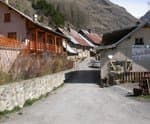The Pissarotte waterfall
Mireille Coulon, park ranger.
15 points of interest
 Vernacular heritage
Vernacular heritageCommunal oven
This is located in the basement of the former school (now the Park Information Centre). It is regularly used on the occasion of local festivals and events. Architecture
ArchitectureHamlet of Les Gourniers
The old houses of the hamlet are modest in appearance. They are built from stone and have sheet metal roofs. They used to be roofed with slate extracted from the nearby quarries Architecture
ArchitectureChapel of the Nativity
It is difficult to be sure of the chapel's date of construction, but is existed in 1700. The bell was installed in 1870, but the bell tower was built in 1956. In 2013, a new larch shingle roof replaced the old corrugated iron roof, Fauna
FaunaBrown trout
This wild trout of the salmonid family is 25 to 100 cm long. Its streamlined body and well-developed fins make it a very efficient swimmer in fast-flowing water. The deepness of the colour on its back varies depending on the environment. Its back and sides are decorated with black dots outlined with pink. Geology and geography
Geology and geographyGiant’s cauldron
The term ‘Giant’s cauldron’ describes a cavity created by a current of water in a standing rock. Here, the waters and the pebbles of the Chargès torrent whirl around polishing the cavity and giving it its spectacular shape.
 Flora
FloraMartagon lily
In the undergrowth at the start of the route, it is remarkable for its long, upright flowering stem. It has three to ten purplish-pink flowers dotted with purple, with long orange stamens. But admire it without breathing it in, because it's as smelly as it is beautiful! Flora
FloraAlpine clematis
A woody climbing plant. Its twisting stem and leaves, delicately clinging to any support that happens to be in its vicinity, help it to scramble upwards into the sunlight. Its flowers are large and pendulous, generally with four petals which are light blue to purplish blue in colour. Fauna
FaunaWhite-throated dipper
The white-throated dipper is easy to spot if you are discreet. It lives by mountain rivers and streams. A small red and grey bird with a short tail, a tapered beak and a white patch from chin to chest. This astonishing sparrow is unique in that it walks along the waterbed against the current, in search of food. It flattens itself and grips the bottom with its fingers, opens its eyes, protected from the water by a thin membrane, and spots worms, larvae, small crustaceans and fish. Flora
FloraMeadow sage
Also known as wild sage, it is the largest plant in the mint family. It boasts a highly specialised pollination mechanism. Insects that insert their proboscis into the flower to reach the nectar receptacle trigger the other end of the structure, causing it to tilt forward to touch the insect's back, enabling the plant to reproduce. It also has a host of medicinal properties, particularly in the fight against bronchitis, angina, flu etc... Flora
FloraMartagon lily
The martagon lily is distinctive for its long upright flower spike. It bears 3 to 10 flowers which are violet-pink streaked with purple, out of which its long orangey stamens emerge. It’s better to admire it from a distance because, beautiful as it is, it has an unpleasant smell! Flora
FloraCupid's dart
This 30 to 70 cm high plant has slender leaves, some linear with a few narrow side lobes. It is distinctive for its flower heads with parchment-like, translucent bracts and a broad russet median vein ending in a little point. The flowers are all ray-shaped and serrated at the tip. They are blue to purplish, darker at the base. Flora
FloraBurnt-tip orchid
Its name comes from the deep purple colour at the end of the flower spike. 10 to 30 cm tall, this orchid grows in sunny meadows, in limey soil. The flowers are small and arranged into a tight spike. Flora
FloraBeech
A majestic tree with a smooth, steel grey trunk. It has bright, shiny leaves which turn to russet in the autumn. The seeds, or beechnuts, are set into a small spiky woody shell. Here, the beech is growing at the limit of its distribution; they are at their highest in the Durance valley. Flora
FloraYellow gentian
It is easy to see why this perennial plant, with a strong, hollow stem and which can grow up to one metre tall, is commonly called the great gentian. At the end of the stem, it carries several tiers of yellow flowers grouped into whorls, supported by a pair of large opposing leaves. This species can be told apart from others in the genus not only by its colour but also because the corolla is made up of five or six petals. Fauna
FaunaCarrion crow
The carrion crow is a medium-sized corvid, slightly larger than the rook. It is easy to avoid confusing them, as the latter has a narrower, straight beak with a whitish base. Its plumage creates green reflections. The males and females are identical in appearance when young.
Description
- Turn right after the last house, pass the marmite des géants and continue to the bridge over the Réallon stream.
- From there, turn left and head up the path.
- At the fork with signposts to the waterfall, take the path to the right and follow it to the overhanging platform.
- Departure : Les Gourniers, Réallon
- Arrival : Les Gourniers, Réallon
- Towns crossed : Réallon
Altimetric profile
Information desks
Tourist office Réallon Station
Pra Prunier, 05160 Réallon
July and August : Monday to Friday : 9.00 -13.00 and Saturday 13.00 - 17.00
From mid-December to March : Monday to Sunday :9.00 - 12.30 & 14.00 - 17.00
Information center "les Gourniers" (summer only)
Les Gourniers, 05160 Réallon
Les Gourniers
05160 Réallon
Tel :
embrunais@ecrins-parcnational.fr
Maison du Parc de l'Embrunais
Place de l’Église, 05380 Châteauroux-les-Alpes
Information, documentation, exhibition, screenings, products and books of the Park. Accessible to people with reduced mobility. Free admission. All animations of the Park are free unless otherwise stated.
Access and parking
Parking :
Accessibility
Source

Report a problem or an error
If you have found an error on this page or if you have noticed any problems during your hike, please report them to us here:


